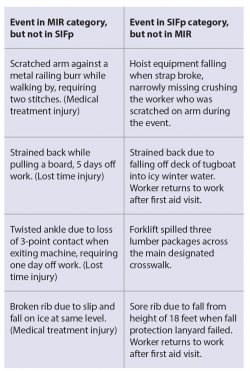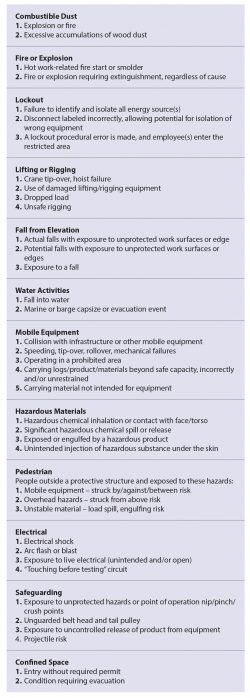
Industry News
News
Health and Safety
Sawmilling
Getting ahead on safety: predicting and eliminating high-severity events
May 15, 2020 By Lana Kurz and David Murray
The forest industry needs to get ahead of the next crisis in safety. We need to predict injuries and proactively respond. One way is to look at how workers are getting hurt and to assess and respond to all recordable injuries, including minor injuries.
But what about those incidents that had the potential to be much more serious but where no one was actually hurt? Do we go far enough to identify and investigate these events – where a life-altering injury or fatality was thankfully dashed? Or do we spend our time and resources investigating incidents where the worst possible outcome was only the relatively minor injury that actually occurred?
 For years, the forest industry has paid close attention to the medical incident rate (MIR) as well as the recordable injuries that contribute to this statistic. However, some Manufacturing Advisory Group (MAG) companies are looking at different ways to prioritize safety resources, based on “significant incident failure potential” events, or SIFp events.
For years, the forest industry has paid close attention to the medical incident rate (MIR) as well as the recordable injuries that contribute to this statistic. However, some Manufacturing Advisory Group (MAG) companies are looking at different ways to prioritize safety resources, based on “significant incident failure potential” events, or SIFp events.
“As an organization matures, they don’t shy away from safety events that are downright scary,” says Andrew Horahan, vice-president of western operations with Interfor. “Treating SIFp events like any other incident is a mistake. Instead, if you treat SIFp events as if they did result in a life altering injury or a fatality, you will discover a deeper level of preventative corrective actions will result.”
What is a SIFp event? It’s another metric intended to draw attention to significant events which may be overlooked or excluded from the MIR statistic. Identifying SIFp events is intended to red flag events which are categorically higher risk and deserve focus and attention through robust investigations on causal analysis and recommendations to prevent re-occurrence.
The difference is focusing efforts on high-risk events rather than on medical injuries.
To determine if an event falls into the SIFp category, answer positively to either/both of these two questions:
- Had circumstances been slightly different, is it reasonable to believe that the event could have resulted in a significant injury or fatality? If yes, then the event is an SIFp.
- If the situation was repeated one hundred times, is it reasonable to conclude the outcome could eventually be a significant injury or fatality? If yes, then the event is an SIFp.
 MAG companies are looking at high-risk areas of exposure and are putting potential SIFp exposures into categories to make identification, classification and tracking of SIFp’s easier for their organizations.
MAG companies are looking at high-risk areas of exposure and are putting potential SIFp exposures into categories to make identification, classification and tracking of SIFp’s easier for their organizations.
“MAG’s mandate is to drive the risk of serious injuries and fatalities out of our industry,” says David Murray, Gorman Group safety manager and MAG chair. “I have seen firsthand the alignment with that mandate through Gorman Group shifting how it measures and manages critical safety risk by using the SIFp process. I see the industry adoption of this metric as a continuity of MAG moving towards our risk-based MAG-SAFE safety audit from prior administrative-focused audits.”
Gorman Group CEO Nick Arkle says, “Focusing on SIF potential brings more awareness to those connected to safety to remove the ‘we were lucky’ from an incident. It now becomes: if the circumstances had only been slightly different, we could have experienced a fatality. It focuses all efforts on eliminating those root causes.”
These companies want to focus energy and resources on incidents that had potential to have much more dire consequences so that they can find ways to prevent a similar recurrence. Tracking SIFp events and determining incident trends aids in the development of resources to eliminate or reduce exposures to employees. They also want to share what they learn with others in industry. If one of these SIFp events has learnings that the rest of industry can benefit from, they can share it with BCFSC to distribute through the Manufacturing Safety Alert process. The Safety Alert includes a brief description of the incident, suggested actions and key takeaways. In this process, BCFSC reviews each incident and removes all identifying information to protect privacy.
“Using the SIFp metric within West Fraser has helped us by focusing our resources and activities on events that could have had much more serious consequences,” Troy Withey, West Fraser safety manager, says.
To sign up for the weekly manufacturing safety alert distribution, go to: www.bcforestsafe.org/node/3409.
Lana Kurz, RPF, is the safety and environment manager for Interfor Corporation, Western Operations.
David Murray, CRSP, is the corporate safety, HR and environment manager for Gorman Group.
Print this page